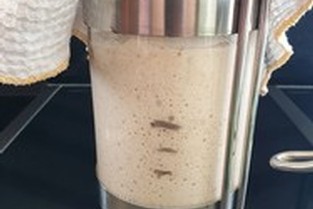Sourdough Table Loaf

This loaf is a basic, everyday bread harnessing the microbial power of sourdough as natural leavening using stone-ground flours.
Marthinus Strydom
Sourdough Starter
The Story
Sourdough is the oldest form of leavened bread and was used at least as early as ancient Egypt. It was probably discovered by accident when bread dough was left out and good microorganisms -- wild yeast -- drifted into the mix. The resulting bread had a lighter texture and better taste. Practice this recipe until you feel comfortable with the process and the flours you have sourced before moving on to other more complicated recipes. Home ovens vary widely in their performance.

Subscripe to my Facebook page.
Subscripe to my Youtube channel.
© All recipes are copyright protected by TheCultureCook.com unless the recipe was adapated from another source. All recipes are uniquely crafted and adapted by TheCultureCook.com. This recipe was adapated from a recipe by https://food52.com/recipes/80565-table-loaf and copyright of some or all of the text reside with the original author.
Ingredients
Method
- Add the flour to a clean mixing bowl. Mix the salt through the flour. Add the water and sourdough starter to the flour. Combine all the ingredients together to form a rough dough. Leave for 10 minutes to rest.
- Turn the dough out onto a clean surface and knead for approximately 10-15 minutes or until the windowpane effect has been achieved. The dough should be smooth, soft and elastic.
- At this point you can add some extra ingredients such as finely chopped rosemary and olives. Springle the extras on the dough and continue kneading until properly incorporated into the dough.
- Return the dough to the mixing bowl, cover with cling film and allow the dough to prove for 4 hours at room temperature.
- After 4 hours turn the dough onto a clean work surface and knock the dough back. Knocking back the dough simply involves knocking the air from the dough which helps to equalise the temperature within the dough. Divide the dough into two.
- The next step you will do with each bread: Form the dough into a tight round ball.
- Prepare a proving basket by lightly dusting with flour. Place the dough, seamed side facing up, into the proving basket, cover with a plastic bag and place into a fridge and leave overnight.
- To bake, preheat your oven to 230°C. Place your cast iron Dutch oven with the lid on in the oven.
- Carefully turn your dough out from the proving basket onto baking paper dusted with flour (the domed side with the indentations from the proving basket should now be facing up and the seamed side on the baking paper).
- Using a sharp knife cut the surface of the dough, this is what is known as the baker’s signature. The dough can be cut up to ½ cm deep. (This isn’t just for aesthetics, scoring the bread also helps control where and how it rises while baking)
- When the oven has reached 230°C, open the oven and remove the lid from the dutch oven. Be careful!
- Pick up the bread on the baking paper by gripping the edges of the paper. Place gently into the dutch oven. Place the lid on. Bake for 20 min.
- Remove the lid from the dutch oven and continue baking for another 20 min until the crust is dark.
- Once done, turn the oven off and open the door. After 20 min remove from the oven and let the bread cool completely on a rack. Don't cut the bread until it has cooled completely. This will take about 1 hour.
